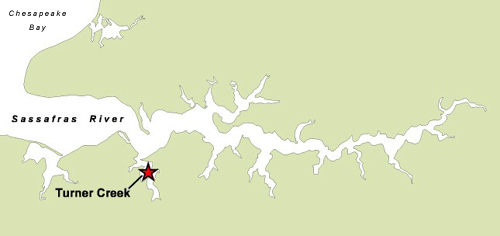|
July 22, 2003
Microcystis blooms on the Sassafras River / MDE Press Release regarding the blooms. |
Localized blooms of the blue-green algae Microcystis were identified by Maryland Department of the Environment (MDE) personnel on July 18th on Turner Creek, a tributary to the Sassafras River. Maryland Department of Natural Resources surveyed the main river and tributaries on July 22nd and observed elevated concentrations of the algae in the main channel of the Sassafras River and the Turner Creek area.
During 2000, a bloom of Microcystis was widespread in the upper Bay and its tributaries. Samples from the 2000 bloom in the Sassafras River were found to contain levels of a toxin that could cause skin irritation and gastrointenstinal discomfort to swimmers and which led to temporary beach closures at Betterton Beach. Microcystis blooms occurred again on the Sassafras River in 2001 but were less severe. The following additional information has been excerpted from the July 22nd MDE Press Release: Marylanders are urged to take precautions when utilizing certain waterways as blue-green Microcystis algae blooms are being reported by the Maryland Departments of the Environment and Natural Resources. Current surveys show that Microcystis blooms have been observed along tributaries of the Sassafras River on the Eastern Shore. Microcystis may contain a toxin that can cause health problems in humans and animals that come in contact with or drink the water. As a result, the environmental health directors of Kent and Cecil counties were directed to post notice of the bloom along Turner’s Creek. Environmental conditions may be appropriate for the development of blooms in other parts of the upper Chesapeake Bay as the summer progresses. In hot weather, and especially in still water with high levels of nutrients, blue-green algae can grow and accumulate rapidly, causing a “bloom.” Although there have been no reported cases of human illness, people should take common precautions to reduce the risk of illness or discomfort related to Microcystis:
Maryland Departments of the Environment and Natural Resources are monitoring the situation. Maryland Department of Natural Resources crews are surveying the Sassafras River on July 22, and will collect samples for toxin analysis. Future developments will be made public as necessary. Blue-green algae naturally occur in tidal freshwater portions of the Chesapeake Bay and its tributaries. However, algal blooms may periodically use up oxygen, causing fish to suffocate and die. Affected waters may also appear as if a blue-green to yellow-green paint is floating on the surface of the water. Major blue-green algae blooms were last reported in the region in 2000. A fact sheet on Microcystis and the 2000 bloom can be found on the Department of Natural Resources’ website. To report a fish kill or fish health related event, call the Fish Health Hotline at (888) 584-3110, 24 hours a day. |

